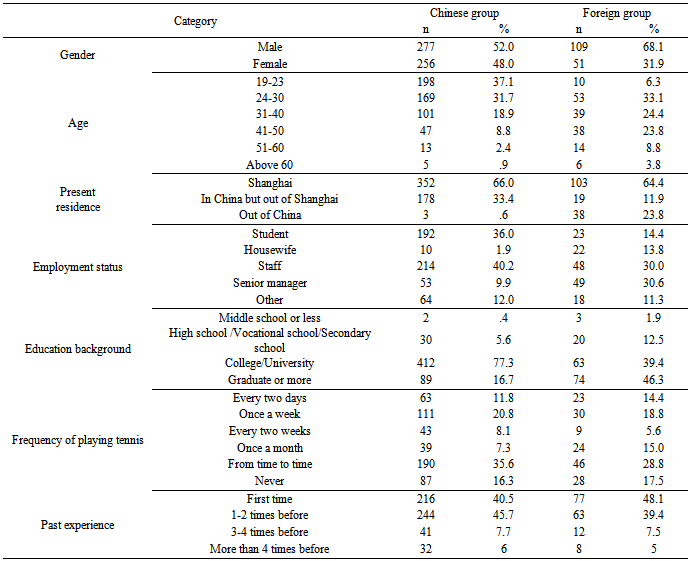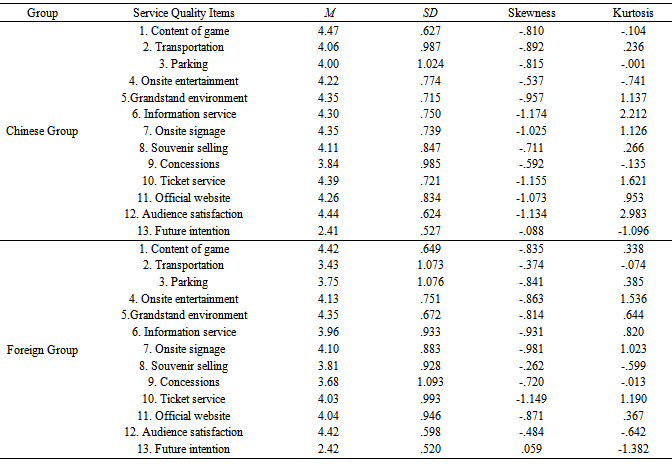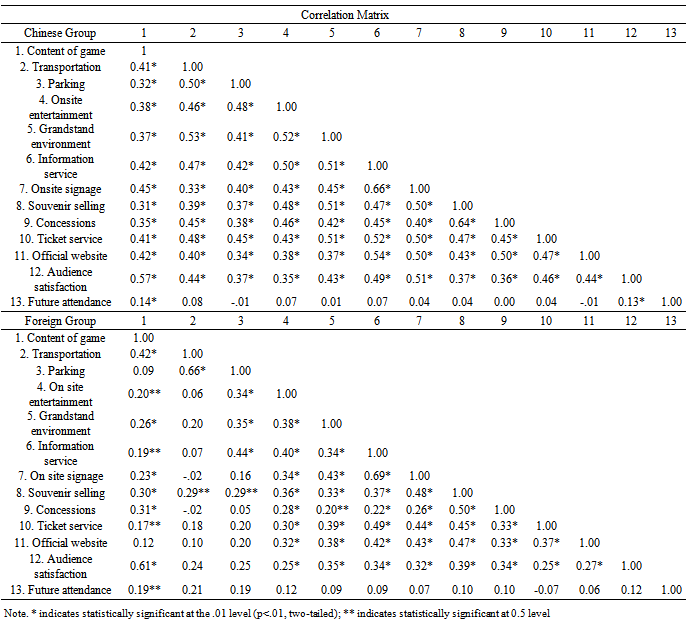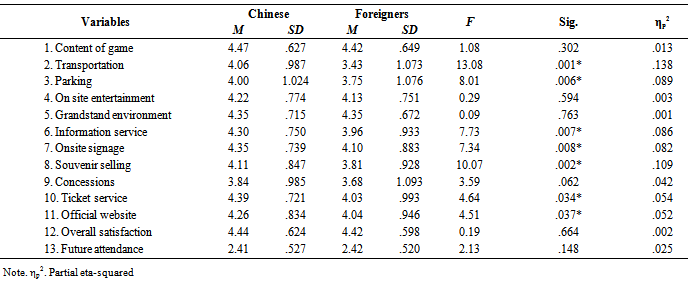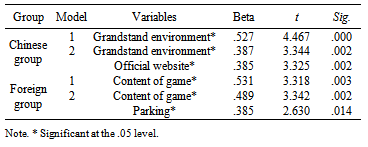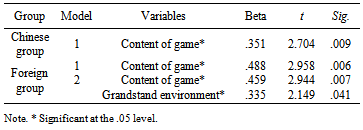-
Paper Information
- Paper Submission
-
Journal Information
- About This Journal
- Editorial Board
- Current Issue
- Archive
- Author Guidelines
- Contact Us
International Journal of Sports Science
p-ISSN: 2169-8759 e-ISSN: 2169-8791
2014; 4(2): 50-59
doi:10.5923/j.sports.20140402.03
The Relationship among Service Quality, Satisfaction, and Future Attendance Intention: The Case of Shanghai ATP Masters 1000
Yinghui Zhang1, Donghun Lee2, Lawrence W. Judge2, James E. Johnson2
1School of Economic and Management, Shanghai University of Sport, Shanghai, 200438, China
2School of Physical Education, Sport and Exercise Science, Ball State University, Muncie, IN, 40736, USA
Correspondence to: Donghun Lee, School of Physical Education, Sport and Exercise Science, Ball State University, Muncie, IN, 40736, USA.
| Email: |  |
Copyright © 2014 Scientific & Academic Publishing. All Rights Reserved.
Little attention has been paid to the role of cross culture in predicting audiences’ attendance intention. Therefore, this study was primarily designed to identify the cultural difference in two groups (Chinese audience and foreign audience) pertaining to the perception of service quality, satisfaction and future attendance intention and their relationships at an international tennis event in China. The results indicated that the Chinese audience evaluated service quality and overall satisfaction significantly higher than the foreign audience. Among eleven service quality factors, Grandstand Environment and Official Website services were the most influential factors of satisfaction perceived by Chinese audiences; while, Content of Game and Parking services were significantly related to the satisfaction perceived by foreign audiences. Content of Game in the Chinese group and Grandstand Environment in the foreign group were significantly associated with future attendance intention. Our data suggest that the sports managers and marketers must establish and implement different strategies that are designed specifically to target local and foreign audiences that attend a mega sporting event while providing an attractive and entertaining game for both groups as the key to success.
Keywords: Service Quality, Audience Satisfaction, Future Attendance Intention, Cross Culture
Cite this paper: Yinghui Zhang, Donghun Lee, Lawrence W. Judge, James E. Johnson, The Relationship among Service Quality, Satisfaction, and Future Attendance Intention: The Case of Shanghai ATP Masters 1000, International Journal of Sports Science, Vol. 4 No. 2, 2014, pp. 50-59. doi: 10.5923/j.sports.20140402.03.
Article Outline
1. Introduction
- Tennis is one of the most popular sports in many countries, resulting in a booming global market with huge commercial value. A recent report from IEG (International Events Group, 2013) revealed that the worldwide tennis sponsorship spending demonstrated sustainable growth from 581 million US dollars in 2009 to 667 million US dollars in 2012, and it is expected to set a new record of 708 million US dollars in 2013. China has also witnessed a significant change in the size of the tennis market in the past decade. According to data gathered through a 2009 survey of the Chinese Tennis Association (CTA), the number of people playing tennis in China has reached 8.12 million, and subsequently tennis facilities have increased at an annual rate of 12%. Likewise, international tennis events have become very attractive to the public in China. Shanghai ATP (Association of Tennis Professionals) Masters 1000 is the only ATP Masters 1000 event in Asia. This event has become very popular in Shanghai and across the nation since its inaugural launching in 2009. The organizing committee announced the Shanghai ATP Masters 1000 attracted approximately 148,000 fans who attended the event. Launching a large scope event, such as the ATP Masters 1000 has escalated the growth rates of participation, as well as consumption of related products across the nation. For example, the number of people owning tennis equipment and playing tennis at least once a week in Shanghai has increased from 540,000 in 2006 to 920,000 in 2012. This has generated an estimated 245 million US dollars of tennis-related products/services (Zhu, 2012).Attendance is one of the critical criteria through which the success of a sporting event can be measured, as was the case for the Shanghai Masters. In order for the Shanghai Masters to be successful, management personnel must learn the characteristics of sports audiences and develop effective event management strategies. For continued growth of the Shanghai Masters, it is imperative to understand, maintain, and improve audience support and loyalty. To accomplish this, it is necessary to investigate the audiences’ perception of service quality and satisfaction with the event along with their future attendance intentions. Scholars in various disciplines have commonly found that service quality positively influences the satisfaction while subsequently impacting future intentions (Kim, LaVetter, & Lee, 2006; Koo et al., 2009; Yoshida & James, 2010). Surprisingly, there is a lack of research in which sport marketing researchers examine perceptions of service quality, satisfaction, future intention, and their relationships in a cross-culture perspective. Yoshida and James performed one of the few cross-cultural studies on service quality and consumer satisfaction. Yoshida and James tested a model explaining relationships among service quality, core product quality, game and service satisfaction, and future intentions toward professional baseball audiences in Japan and college football spectators in America. They found that game satisfaction had a significant impact on behavioural intentions across the two settings (Japan and America), while the service satisfaction-behavioural intentions relationship was significant only in Japan. Yoshida and James presented a possible explanation for the variance in findings across the two groups to be associated with spectators’ different attitudes toward different sporting events. That is, spectators may continue supporting their favourite college football teams regardless of service (dis) satisfaction with the game, but spectators of another sport, such as professional baseball, may base their responses on service outside of the actual game. Therefore, to more accurately examine cross-cultural differences, examiners may benefit from considering data comparability as Chun, Gentry, and McGinnis (2004) suggested. Chun et al. focused on fan ritualization from a cross-cultural perspective in American and Japanese baseball fans. It would be proper to select a comparative research domain, such as fans of sporting events of the same type or the same sports in different cultures. In this context, the current study investigated the audience’s behaviours cross-culturally by examining the differences between Chinese and foreign audiences of an international tennis sporting event in China. More specifically, this study aimed to explore the differences regarding the perceptions of service quality, overall satisfaction, and future intention. Additionally, this study aimed to examine cross-cultural difference between the Chinese and foreign audiences by measuring the difference of the relationships between service quality, satisfaction and future intention across these two groups.The Chinese scholars have dedicated their research to that of audience behaviour during the last decade when the sports event industry began to embrace dramatic development in China (Wang, 2013; Wang, 2012; Zhan et al., 2011; Zhu, 2011). However, a lack of empirical research on service quality of sporting events and factors affecting consumers’ intention to watch the game live was indicated (Cao & Zhang, 2011; Huang, Zhang, & Zhao, 2010). The feedback from this study will help managers better understand the audiences’ evaluations of service quality, the impact of satisfaction on future intentions, and the differences between domestic and foreign audiences. Consequently, making strategic improvements to increase game attendance will occur. In addition, future sponsors may be interested in additional data regarding demographic composition, as well as, audience satisfaction and customer trends of a global tennis event like the Shanghai Masters in a developing country similar to China.
2. Theoretical Background
2.1. Service Quality
- There is a general consensus that service quality is composed of a number of underlying dimensions (Murray & Howat, 2002). Parasuraman, Zeithaml, and Berry (1988) proposed five dimensions of service quality that included responsiveness, assurance, tangible, empathy, and reliability. Among them, the SERVQUAL scale developed by Parasuraman, et al. has been the most widely accepted and cited framework explaining service quality in various settings (Kim & Lough, 2007). Since its inaugural introduction to the literature, there has been some criticism to this measurement scale. Several scholars argued that the components of SERVQUAL are not applicable to all service industries and should be tailored to the context being examined (Cronin & Taylor, 1992; Finn & Lamb, 1991). To fill the gap in the literature, more pertinent models for measuring service quality have been constructed. For example, Howat, Murray, and Crilley (1999) introduced a three-factor model of service quality including personnel, core and peripheral service quality. In a slightly different way, McDougall and Levesque (2000) proposed that service quality is composed of two overarching dimensions: the core (what is delivered) and the relational (how it is delivered). Van Leeuwen, Quick, and Daniel (2002) defined the core product function of the game as core service quality and categorized game support programs as peripheral services. However, Murray and Howat argued it was also acceptable to measure relational service quality as a combination of attributes that reflect the personnel or peripheral factors. In the current study, we adopted core and peripheral services as two dimensions of service quality due to its more global approach (Murray & Howat, 2002) and the feasibility of distinguishing the core and peripheral dimensions of service quality.
2.2. Customer Satisfaction
- Customer satisfaction is one of the key variables explaining behavioural intentions in marketing. Oliver (1997) defined customer satisfaction as a judgment that a product or service feature, or product or service itself, provided (or is providing) a pleasurable level of consumption-related fulfilment. As this definition implies, the perception of satisfaction is a subjective evaluation by consumers. The literature generally suggests that service quality positively affects the customer satisfaction.Murray and Howat’ (2002) investigation supported this relationship between service quality and satisfaction for customers at Australian public sports and leisure centres. They stated that the core and relational service quality significantly influenced customer satisfaction, while relational service quality explained slightly more of the variance than core service quality in the overall customer satisfaction. Koo et al. (2009) adopted a three-factor model of functional, technical, and environmental attributes, as the dimensions of service quality, to examine the causal effects between dimensions of service quality and spectator satisfaction in minor league baseball. Functional, technical and environmental attributes were reported as significant determinants of perceived service quality which, in turn, has salient effect on spectator satisfaction. In this way, previous studies had repeatedly confirmed the impact of service quality and satisfaction. There is no doubt that managers are to continuously seek and adopt procedures to understand, evaluate, and improve on the quality of services provided to their customers (Tsuji, Bennett, & Zhang, 2007).
2.3. Future Behavioural Intentions
- Ajzen (1991) suggested that even though future intentions do not always lead to an actual behaviour, they do imply a high likelihood of future behaviours. This means that measuring future intentions of audiences is very important for the continued success of an event (Kim & Lough, 2007; Shonk & Chelladurai, 2008; Tsuji, Bennett, & Zhang, 2007). Behavioural intentions are usually described as repeat purchase or repurchase intentions (Cronin et al., 2000; McDougall & Levesque, 2000; Murray & Howat, 2002) because it demonstrates willingness (enthusiasm) to repurchase a product or service (Mitall, Rose & Baldasare, 1998). Intentions to attend future sporting events were the most widely-examined dependent variable in sport marketing literature (Shonk & Chelladurai, 2008; Tsuji, Bennett, & Zhang, 2007). For a service organization, attaining and maintaining a high level of customer repurchase (or repeat game attendance) intention is needed to be an ongoing process (Bhote, 1996). Typically, future attendance intentions were assessed by asking participants about the likelihood they would attend the event next year (Murray & Howat, 2002; Kim, et al., 2006; Kim & Lough, 2007; Shonk & Chelladurai, 2008; Tsuji, Bennett, & Zhang, 2007).Oliver (1997) pointed out that ‘satisfaction itself is a desirable end state of consumption or patronization; it is reinforcing, pleasurable experience’ (p.10). Consumers are loyal to the service providers who satisfy them (Kennett, Sneath, & Henson, 2001). That is, if a customer is satisfied with the consumption experience, it is highly predicted that he/she would like to repurchase this product or service in the future; if not, the chance of the customer to seek an alternative is greatly increased. There is convincing evidence suggesting that customer satisfaction has significant effects on profit via its influence on customer retention (Anderson, Fornell & Lehman, 1994; Cronin, Brady, & Hult, 2000). Sports organizations are encouraged to continuously meet or exceed audiences’ expectations and perceptions regarding service experiences if they are to maintain and grow the number of audiences and future attendance (Kennett et al., 2001). A satisfactory experience resulting from attending sporting events would appear to be an important predictor of a fan’s likelihood of attending future events (Madrigal, R., 1995). Other researchers (Murray & Howat, 2002; Kim, et al., 2006; Kim & Lough, 2007; Tsuji, Bennett, & Zhang, 2007; Yoshida & James, 2010) have also found satisfaction is a key determinant of attending the sporting event or recommending it to others in the future. The relationship between service quality and future intentions has also gained much attention. Tsuji, et al. (2007) indicated that only peripheral service quality is influential when expressing future attendance intentions; however, both core and peripheral service qualities, have indirect effects on future intentions via satisfaction. In the research of Kim et al. (2006), factors including empathy, assurance, responsiveness, and tangibles were identified as most critical in overall repurchase intention. This may suggest that the service quality may have a direct effect on intention to return, but an indirect effect through satisfaction with the service (Shonk & Chelladurai, 2008). Unlike the findings of Shonk and Chelladurai, some researchers supported the theory of the service quality-satisfaction-behavioural intentions chain, while neglecting consideration of a direct impact of service quality on future intentions (Murray & Howat, 2002; Yoshida & James, 2010). Existence of some contrary findings suggests further research on the relationships among service quality, satisfaction, and behavioural intention in the context of sports. Based on the aforementioned literature, two hypotheses were tested in the current study. Cross-cultural differences were examined by testing these two hypotheses in the Chinese and foreign groups respectively:H1: Service quality is significantly related to audience satisfaction;H2: Service quality and audience satisfaction are significantly related to future intention.
3. Methods
3.1. Participants and Data Collection
- Using the stratified random sampling technique, data collection was conducted throughout the nine event days at the 2013 Shanghai Masters in China. Four graduate students were recruited to collect data using a guideline to broaden diverse population (Cronin, Brady, & Hult, 2000). English speaking data collectors were recruited and utilized in order to collect data from international visitors (those visiting from outside of the country of China). Collectors situated themselves at the rest areas between the playing courts and approached the audiences who were taking a break during or after a match to request their participation in the survey. The respondents were informed of the purpose of the study, the time the questionnaire would take, and were assured their information would be completely confidential and used for research only.A total of 749 questionnaires were initially collected. Due to incompleteness, 56 were excluded from data analysis. The final sample consisted of 533 Chinese (77%) and 160 foreign visitors (23%). Approximately 52% of Chinese visitors were males, 48% were females while 68.1% of foreign visitors were males and 31.9% were females. The ages of respondents ranged from 19 to 78 years old with 68.8% of Chinese sample and 39.4% of foreign sample being equal to or under 30 years old. Additionally, 66% of Chinese respondents and 64.4% of foreign respondents presently live in Shanghai, and the majority of them (59.5% of Chinese respondents and 51.9% of foreign respondents) have watched Shanghai Masters or Shanghai Masters cup at least once in the past. Detailed descriptive information of the socio-demographic audience characteristics are presented in Table 1.
3.2. Instrumentation
- A pencil and paper questionnaire was used to measure the perceptions of service quality, audience satisfaction, and future attendance intention among the audiences of Shanghai ATP Masters 1000 in 2013. Service quality was measured in two aspects: core service quality and peripheral service quality. Core service quality was operationalized as the core product offerings of the game; while peripheral service quality was defined as non-game related services (Van Leeuwen et al., 2002). This study measured the content of the game (i.e. the performance and competitiveness of the game) to assess the core service quality. The dimensions of peripheral service quality were determined based on the services provided for the audiences of the event. Ten items were included to measure peripheral service quality, including the following; onsite entertainment (concerts and music), transportation, parking service, grandstand environment (security, seat cleaning, order etc.), on-site information service (information publishing, consultation service etc.), onsite signage (ease of entrance), souvenir selling, concessions, ticket service, and official website. All items were anchored on a 5-point Likert-type scale, ranging from 1(very low) to 5 (very high). Audiences’ overall satisfaction was rated on a question using a 5-point Likert-type scale ranging from 1(very dissatisfied) to 5 (very satisfied). Lastly, future attendance intention was measured on a three-point scale including will not come, may come, and surely will come. Demographic information was also collected as illustrated in Table 1.
|
3.3. Validity
- The questionnaire was presented to a panel of five experts to ensure the construct validity. Two of the experts were managers from the Shanghai Tennis Masters organization committee, who had substantial practical experience of sporting events and were well informed about the service being provided at the event. The other three were faculty in the field of sport management in a Mid-eastern university in Shanghai. The panel of experts was asked to review the questionnaire in terms of representativeness and relevance of the items. An item related to official website service was added based on the experts’ feedback, due to the official website being the first place the event committee released the latest updates and news reports about the games, such as the game schedule of the next day.
3.4. Pilot test of Questionnaire
- A pilot test was conducted with 20 local students majoring in sports marketing and 5 international graduate students attending the university (two Americans and three Australians). Based on their feedback, the questionnaire was slightly revised and then reliability was measured. Cronbach’s alphas for service quality were 0.90 and 0.76 in the Chinese and foreign groups, respectively. IRB approval was obtained before the survey was distributed at the event.
3.5. Data Analysis
- Using SPSS 21.0, descriptive statistics were calculated to examine the audiences’ overall rate of perceived service quality, satisfaction, and future attendance. Using correlations, discriminant validity was examined. Additionally, a multivariate analysis of variance (MANOVA) was conducted to assess the group difference in the overall factors within the Chinese and foreign groups. In addition, regression analyses were adopted to examine the extent to which service quality had significant impact on future attendance intention with the moderating effect of audience satisfaction across the Chinese and foreign groups.
4. Results
4.1. Descriptive Statistics
- In the Chinese group, Content of the Game (M=4.47) produced the highest mean, while Concessions produced the lowest mean (M=3.84). In the foreign group, Content of Game (M=4.42) also had the highest mean, while Transportation had the lowest mean (M=3.39; Table 2).Multivariate normality distribution of the motives was examined. In the Chinese group, skewness and kurtosis values ranged from |0.088| to |1.174| and |0.001| to |2.983|, respectively, indicating normal data distribution. Similar results were found in the foreign group, in that the skewness and kurtosis values ranged from |0.059| to |1.149| and |0.13| to |1.536|, respectively (Table 2).
|
|
|
4.2. Impact of Service Quality on Audience Satisfaction
- In order to examine the impact of service quality on audience satisfaction, a multiple regression considering all 11 service quality factors as independent variables and audience satisfaction as the dependent variable was conducted. It was indicated that the effects of the 11 service s quality factors on the audience satisfaction was statistically significant [F (11, 42) = 3.221, p<0.01] in the Chinese group, explaining about 31.6% of the variance in the audience satisfaction. Similarly, a statistical significance was found between service quality and audience satisfaction in the foreign group [F (11, 18) = 2.638, p<0.01], explaining about 38.3% of the variance in the audience satisfaction.To further determine the service quality factors which significantly impact audience satisfaction, a stepwise regression analysis was conducted. It is suggested that model 2 of these two groups produced the highest R2 of 0.383 and 0.386, respectively. According to the coefficients result in Table 5, Grandstand Environment (β=.387, p=.002) and Official Website (β=.385, p=.002) were found to be significant predictors of audience satisfaction in the Chinese group. In the foreign group, Content of Game (β=.489, p=.002) and Parking (β=.385, p=.014) were the factors which showed a statistically significant impact on the audience satisfaction.
|
4.3. Impact of Service Quality and Audience Satisfaction on Future Intention
- To predict the influence of service quality and audience satisfaction on future attendance, multiple stepwise regressions were applied. The results of regression analysis, using alpha=0.05 for variable entry and alpha=0.1 for variable removal suggested that model 1 [F (1, 52) =7.312, p<0.01] of the Chinese group and model 2 [F (2, 27) =7.249, p<0.01] of the foreign group have the highest R squared values.The coefficient result of stepwise regression analysis was presented in Table 6. It was indicated that Content of Game (β=.351 p=.009) was the only salient predictor of future intention in the Chinese group, while both Content of Game (β=.459 p=.007) and Grandstand Environment (β=.335 p=.041) had statistically significant influence on future attendance in the foreign group.
|
5. Discussion and Conclusions
- This study aimed to gain a better understanding in the differences of perceptions between local and foreign audiences that attend a mega sporting event. Some interesting findings were revealed through the evaluation of the proposed hypotheses in this study. The findings from the first regression model considered eleven service quality factors as independent variables, and audience satisfaction as the dependent variable, indicated statistically significant results, leading to the confirmation of the hypothesis that service quality is significantly related to audience satisfaction. This is consistent with the dominant position in the previous studies, that service quality is a major predictor of customer satisfaction (Cronin et al., 2000; Kim et al., 2006; Koo et al., 2009; Murray & Howat, 2002; Tsuji et al., 2007; Yoshida & James, 2010). Consequently, this position appears to have broad-based empirical support in the context of the sports service industry. The stepwise regression indicated that Grandstand Environment and Official Website services were the most influential factors of satisfaction perceived by Chinese audiences; while, Content of Game and Parking services were significantly related to the satisfaction perceived by foreign audiences. Clearly, the audiences in these two groups assessed their overall satisfaction differently. Chinese audiences emphasize the importance of providing a clean and comfortable grandstand environment, as well as timely and easy website service. Foreign audiences highly evaluate the importance of an attractive game and a convenient parking service. This finding shows that the service being provided, beyond the playing courts (such as official website service, parking service), is critical to improve the service quality, and in turn audience satisfaction.The findings from the stepwise regression analysis indicated that Content of Game in the Chinese group and that Grandstand Environment in the foreign group were significantly associated with future attendance, leading to the partial confirmation of the hypothesis that service quality and audience satisfaction are significantly related to future intention. This finding is consistent with the previous studies (DeSchriver & Jensen, 2002; Li & Hou, 2012; Welki & Zlatoper, 1994; Madrigal, 1995) that suggested the quality of the game strongly influences audiences’ decision to attend a sporting event, which may explain why the audience showed high level of future attendance intention if they were attracted by the high quality of the game. This finding is different with the study of Tsuji, et al. (2006) who indicated that the core service quality (that is, the game itself or the team’s performance) was not influential in explaining future intention. Similarly, Mahony, Madrigal, and Howard (2000) suggested that sport managers may wish to sell the game as one aspect of a whole ‘sport service experience’ rather than focusing on core product. The varying research results may be due to the fact that the study was conducted under different service contexts. Still, it calls for a need for investigations that will obtain a more generalizable result.The difference between the Chinese and foreign audiences, pertaining to the evaluation of service quality, audience satisfaction, and future intention, was found using the MANOVA and ANOVA results. The difference between these two groups was statistically significant; the Chinese audience evaluated the eleven service quality factors and overall satisfaction higher than the foreign audience. Further, Content of Game, Onsite Entertainment, Information Service, Onsite Signage, Souvenir Selling, Ticket Service, and Official Website services were evaluated differently across these two groups.The findings of this study contribute to the knowledge of customer behaviors regarding sporting events in a cross-cultural perspective and lead to recommendations for sports marketers. First, sports marketers need to understand that sporting events offer many different experiences for local and foreign audiences, from parking and concessions, to the event itself. Content of the Game is the most important factor which will affect the audiences’ perceptions of satisfaction and future intention. Thus, providing an attractive and entertaining game is to be the core of sporting events at any time. However, the performance of a game may generally be beyond the control of the sport manager (Kelley & Turley, 2001). Nonetheless, there are some activities in which the sports managers could do to support the game and strengthen the attractiveness of the game. For example, game atmosphere could be a part of the game experience for the audience. Yoshida and James (2010) suggested the combination of game atmosphere and the unique characteristics of the core product (i.e. player performance) help sport marketers satisfy the audiences. In addition, entertainment activities at the game break may also improve the audience’s experience with the game.Second, local and foreign audiences showed differences when they evaluated the services being provided. Data also suggests a difference between the two groups regarding the relationships between service quality, audience satisfaction, and future intention. Market segmentation is a very important step in marketing and in the sports field. Sport managers should consider establishing and implementing different strategies for the local and foreign audiences. For example, certain services may need to be provided differently, such as the access service (e.g. transportation and parking), because the needs for the services vary among the differing audiences.
6. Limitations and Suggestions for Future Study
- The current study includes limitations that need to be taken into consideration when interpreting results. The first limitation may include the omission of service quality variables. For example, this study did not include personnel appearance in the service quality dimensions, because this study was largely based on the specific services in which the sport managers provided for the audiences. Additionally, customer-frontline employee interaction is very important and can impact the effect of the service delivery.Second, the current study did not examine the moderating roles of audience characteristics (i.e. gender, age, occupation, education, and past experience) on the perceptions of service quality, satisfaction, future attendance, and the relationships among these three constructs. A more detailed understanding of what moderators significantly affects the audiences’ evaluations of the game will be beneficial for sport marketer’s strategies.Third, even though future attendance intention is a widely-used outcome, multiple-items measurement may best describe the future intentions of consumers. Multiple-items measurement can fully evaluate the impact of the game on audience’s behaviour (e.g. repurchase intentions, positive word-of-mouth, or customer loyalty; Cronin et al., 2000).In summary, the local and foreign respondents surveyed in this study reported satisfaction with the game and expressed their intention to attend the game next year. The findings of this study offered both theoretical and practical contributions to the existing literature about the relationships of service quality, satisfaction, and future behavioural intention, and also provided several recommendations to sports managers. Still, further research pertaining to those complex relationships needs to be developed in additional contexts.
ACKNOWLEDGEMENTS
- The research was financially supported by Shanghai Municipal Graduate Education Innovation Program. The authors wish to express their appreciation to Researcher Nanzhu Li, School of Economics and Management, Shanghai University of Shanghai for his support on data collection.
 Abstract
Abstract Reference
Reference Full-Text PDF
Full-Text PDF Full-text HTML
Full-text HTML